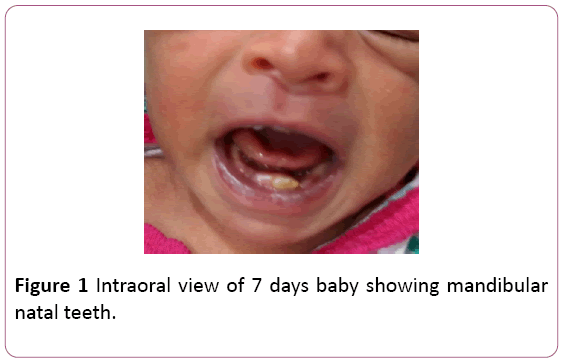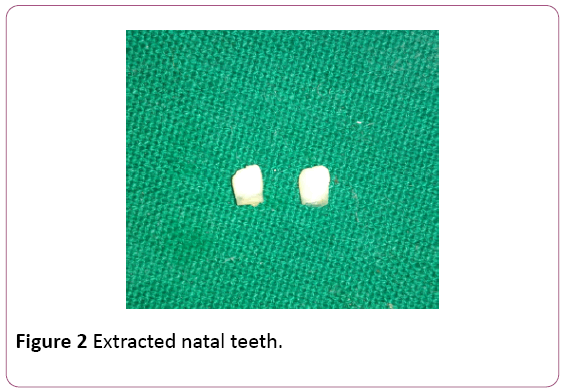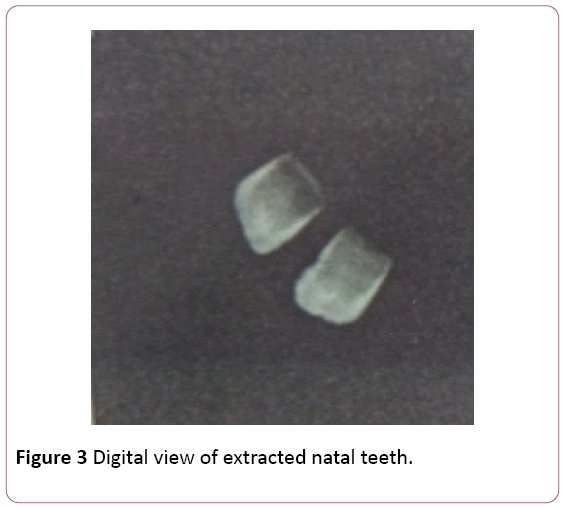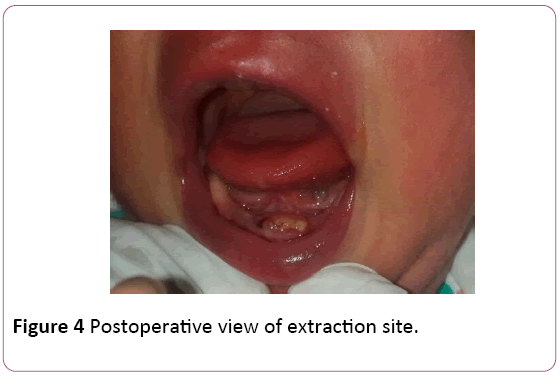ISSN : 2576-392X
Dentistry and Craniofacial Research
Management of Natal Teeth: Paediatric Dentist Role
Anupam Saha, Sujatha Bandi, Mallineni Sreekanth Kumar* and Sivakumar Nuvvula
Department of Pedodontics and Preventive Dentistry, Narayana Dental College and Hospital, Nellore, Andhra Pradesh, India
- *Corresponding Author:
- Mallineni Sreekanth Kumar
Department of Pedodontics and Preventive Dentistry
Narayana Dental College and Hospital, Nellore, Andhra Pradesh, India
Tel: +91-8985833533
E-mail: drmallineni@gmail.com
Received Date: February 15, 2018; Accepted Date: February 19, 2018; Published Date: February 23, 2018
Citation: Saha A, Bandi S, Kumar SK, Nuvvula S (2018) Management of Natal Teeth: Paediatric Dentist Role. J Dent Craniofac Res Vol.3 No.1:2. DOI: 10.21767/2576-392X.100018
Abstract
The occurrence of teeth at the time of birth is called natal teeth. The incidence of this anomaly has been approximately 1:1400 to 1:3500 live births. Most commonly seen in mandibular primary central incisor region and usually occur in pairs. The present case scenario describes about the management of natal teeth in a seven day old new born baby and also the role of paediatric dentist in its management as well as guidance for medical practitioners and parents.
Keywords
Natal teeth; Complications; Vitamin K
Introduction
Natal teeth are teeth which present at the time of birth [1]. Mandibular lower centrals are most commonly affected teeth with a frequency of one case in 1400-3500 [2,3]. Many synonyms have been proposed such as congenital teeth, fetal teeth, predeciduous teeth, and precocious dentition. However, the current terminology ‘Natal teeth’ proposed by Massler and Savara [1], although this term only defines about the time of eruption and no consideration to anatomy or histology [4]. They usually occur in pairs and eruption of more than two natal teeth is a rare entity. There is no sex predilection in the occurrence of natal teeth [5]. Mostly they are poorly developed with hypoplastic enamel and dentin, poor in texture and have poor or absent development of roots [6,7]. Paedodontist plays a vital role in management of natal teeth because, they can aid in early detection and treatment of these teeth, otherwise it might induce deformity or mutilation of tongue, dehydration; inadequate nutrients intake by the infant.
Case Study
A 7-day-old male patient was referred to department of Paedodontics and preventive dentistry with chief complaint of two teeth in the lower jaw of which one tooth is excessively mobile since birth and also difficulty to mother during breast feeding. The new born child was well nourished with no medical complications and the type of delivery was C-section. Oral examination revealed two teeth in the mandibular anterior region (Figure 1), with whitish opaque colour. Among them one is partially erupted and the other one erupted completely and had grade III mobility. The crown size was normal and gingiva was inflamed, soft with pale yellow red coloured around the tooth that which was excessively mobile whereas on the other tooth it was normal. Hence, from the above clinical findings, a diagnosis of natal teeth was made.
Since the natal tooth was excessively mobile, and the chances of aspiration are more so immediate extraction was the treatment of choice. Prior to extraction, Paediatrician was consulted for the administration of Vitamin K, as it has a role in clotting mechanism and helps in preventing haemorrhage. Intramuscularly 0.5 mg of vitamin K was administered and extraction was done under local anaesthesia (LA). An insulin syringe was used to administer LA for convenience and the patient tolerated well. Both the natal teeth were extracted (Figures 2 and 3) and the socket was curetted gently to remove any remnants of dental papilla. Immediately after extraction pressure was applied using gauge pack, to halt bleeding and few minutes later mother was instructed to breastfed the baby, because it will cause pressure on the gums and stops the bleeding. After achieving complete haemostasis patient was discharged and was recalled after one week, and the recovery was found to be eventful (Figure 4).
Results and Discussion
Natal teeth are more common in mandibular region of central incisors (85%), and this strong predilection is because, these teeth are consistent with the normal order of eruption of primary deciduous teeth, followed by maxillary incisors (1%), mandibular canines and molars (3%), and maxillary canines and molars (1%) [8]. Many authors have reported a varied incidence of these natal teeth, with Massler and Savara [1] reporting about 1 in 2000 births. Most commonly these teeth are erupted from normal complement of primary dentition (90%-99%) and only (1%-10%) of them are supernumerary [9].
Generally, no intervention is required if these natal teeth remain asymptomatic or if they do not interfere with breastfeeding. Tooth extraction is indicated if tooth is supernumerary or excessively mobile, which is associated with risk of aspiration [5]. Rusmah [10] reported tooth extraction is contraindicated in new born because of risk of haemorrhage. Consequently it has been suggested, Vitamin K need to be administered (0.5-1 mg) intramuscularly prior to extraction. Vitamin K is generally produced by the commensal flora of intestine, which is essential for the production of prothrombin in the liver and it also regulates four important clotting factors (II, VII, IX, X) required in the extrinsic pathway of haemostasis. Because of the absence of commensal flora in the intestine vitamin K is not produced in new born babies, and in such cases if extraction is done it would lead to uncontrolled haemorrhage. It has been suggested to wait until a child is 10 days old before extracting the natal tooth [11]. In the present case the natal tooth was excessively mobile and to prevent the risk of aspirating the natal teeth, extraction was the opted treatment plan. After applying topical anaesthesia using cetacaine, an insulin syringe was used for administration of LA, because of its smaller gauge needle size which prevents chances of tissue damage. First, excessively mobile tooth was extracted and then adjacent tooth was extracted using anterior forceps. After extraction the socket was curetted gently, to ensure that underlying dental papilla and Hertwigs epithelial root sheath removal done. Root development may continue if these structures are left in situ [10]. If tooth does not interfere with breastfeeding and is otherwise asymptomatic, no intervention is required. It is always necessary to investigate the possible local or systemic factors that could be related to eruption of natal teeth and their association with other pathologies.
Risks for the child due to presence of natal teeth includes (i) risk of swallowing or aspiration if the tooth is excessively mobile (ii) ulceration on the ventral surface of tongue due to sharp incisal edges (iii) possibility of traumatic injury (iv) their presence may cause soreness in the new born and (iv) they might interfere with breastfeeding with resultant feeding refusal and growth retardation. Difficulties for the mother due to presence of natal teeth (i) inconvenience during suckling and (ii) Injury to the mother’s breast such as lacerations, and impediments for the Paediatric dentist due to presence of natal teeth (i) prior to extraction or after diagnosis, a radiograph must be taken to find out whether the tooth is a part of normal dentition or is supernumerary [12].
The role of paediatric dentist is very important in management of natal teeth, since they might pose a variety of complications as mentioned above and management, whether to retain or extract the tooth should be weighed against the risks and benefits with these natal teeth. Periodic assessment of the infant has to be done regularly and every effort has to be made to educate the parents about natal teeth and its consequences. It is the responsibility of pedodontist to have an interdisciplinary approach with the paediatricians whenever infants with natal teeth are encountered.
Khandelwal and co-workers [13] mentioned the importance of nurse’s experience and role in infants with natal teeth, as they guide the mothers as to how to feed the babies and can help breastfeeding mothers in those clinical situations. They can provide information regarding natal tooth, nursing care and support of best practices of breast feeding and also provide a psychological boost for the family. Furthermore they can help in referring such infants to Paediatric dentist for further management.
Conclusion
New born with prematurely erupted teeth must be carefully examined and further treatment planning, as well as parent counselling must be given equal importance to bring awareness among parents. Paediatric dentists should make effort to educate parents as well as medical practitioners regarding the complications with natal teeth and its treatment.
References
- Massler M, Savara BS (1950) Natal and neonatal teeth: A review of twenty four cases reported in literature. JPaediatr 36: 349-59.
- Kates GA, Needleman HL, Holmes LB (1984)Natal and neonatal teeth: A clinical study. J Am Dent Assoc 109: 441-443.
- Leung AK (1986) Natal teeth in American Indians. Am J Dis Child 140: 1214.
- Rao RS, Mathad SV (2009) Natal teeth: Case report and review of literature. J Oral MaxillofacPathol 13: 41-
- Leung AK, Robson WL (2006) Natal teeth: A review. J Natl Med Assoc 98: 226-8.
- Chow MH (1980) Natal and neonatal teeth.J Am Dent Assoc 100: 215-16.
- Ooshima T, Mihara J, Saito T, Sobue S (1986) Eruption of tooth like structure following the exfoliation of natal tooth:Report of a case. ASDC J Dent Child 53: 275-278.
- Zhu J, King D (1995)Natal and neonatal teeth. ASDC J Dent Child 62: 123-128.
- El Khatib K, Abouchadi A, Nassih M, Rzin A, Jidal B, et al. (2005) Natal teeth:Study of five cases. Rev StomatolChirMaxillofac106: 325-327.
- Rusmah M (1991)Natal and neonatal teeth: A clinical and hitological study. J Clin Ped Dent15: 251-253.
- Cunha RF, Boer FAC, Torriani DD (2001) Natal and neonatal teeth: Review of the literature. Pediatr Dent 23: 158-162.
- MallineniSK, Nuvvula S (2015) Management of supernumerary teeth in children: A narrative overview on published literature. J Cranio Max Dis 4:62-68.
- Khandelwal V, Dubey A, Khandelwal S (2015) Nurse’s experience and role in infants with natal teeth. Iran J NursMidwifery Res 20: 409.
Open Access Journals
- Aquaculture & Veterinary Science
- Chemistry & Chemical Sciences
- Clinical Sciences
- Engineering
- General Science
- Genetics & Molecular Biology
- Health Care & Nursing
- Immunology & Microbiology
- Materials Science
- Mathematics & Physics
- Medical Sciences
- Neurology & Psychiatry
- Oncology & Cancer Science
- Pharmaceutical Sciences




